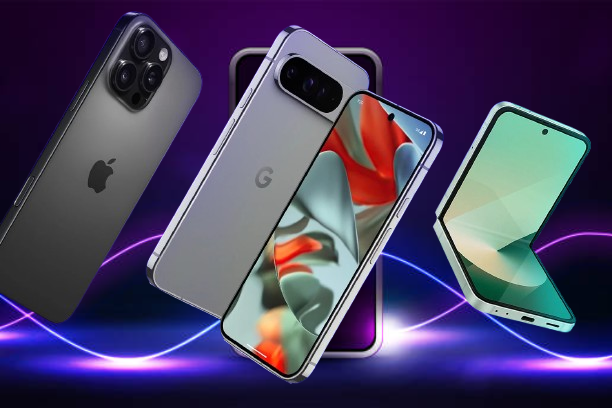
Innovation in Mobile Phones: From Gadgets to Everyday Heroes
Over the years, mobile phones have transformed from bulky communication tools into sleek, intelligent companions in our pockets. In 2025, what once started as a simple call-and-text device is now a lifeline: a personal assistant, a creative studio, and a navigation partner all rolled into one.
- Shrinking Hardware, Growing Capabilities
Think back to early smartphones: thick frames, small screens, modest batteries. Fast-forward to today’s models, and the change is remarkable. Manufacturers have squeezed more power into thinner bodies, often with futuristic features:
Foldable Screens
Phones that bend, flip, or stretch to fit your needs—compact phones that still give you a tablet-sized canvas. They’re still refining the technology, but what seemed like science fiction a few years ago has arrived.
Under‑Display Cameras
Front cameras hidden beneath the screen now give way to uninterrupted, edge-to-edge displays. The sensor fires up from behind the glass—no notch, no punch-hole.
Processor Efficiency
Chips are not just faster—they’re more efficient. Smartphones today run complex apps, intense games, and AI tools smoothly, all while sipping far less power than before.
Battery Innovations
Rapid charging, longer life between charges, and features like reverse wireless charging are turning phones into power hubs for other devices. You can top up your earbuds, watch, or even another phone—all from your main device.
- On‑Device Intelligence
The game-changer in recent years has been on-device AI:
Real-Time Language Translation
Have a conversation in a foreign language? Your phone can now translate speech instantly—no need to type or wait for the cloud.
Smart Photography
Point your camera at anything, and it knows what it’s looking at—pets, food, landscapes—and automatically adjusts color, light, and depth for stunning photos.
Accessibility Features
For visually impaired users, phones can now describe surroundings, read text aloud from physical pages, and guide navigation through voice cues.
These capabilities happen right on the device. No Wi-Fi or data plan required—what matters is speed and privacy.
- Supercharged Connectivity
From 3G to 4G, and now 5G, each wave of connectivity has redefined what phones can do:
5G Power
With lightning-fast data and minimal lag, 5G lets you stream high-definition videos, play online games, and download big files nearly instantly.
eSIM Flexibility
Gone are the days of swapping plastic SIM cards—now you can switch carriers, activate international plans, or manage multiple numbers all from settings—a huge plus for travelers and digital nomads.
Satellite SOS
Some phones now connect to satellites when you’re out of cell range—ideal for hikers, mountaineers, or anyone in remote areas who needs urgent help.
- Sustainable and Long‑Lasting Design
Innovation isn’t limited to tech specs. There’s a growing shift toward sustainability:
Modular Parts
Think replaceable batteries and camera modules you can swap out as needed—no need to replace the whole phone if something breaks.
Recycled Materials
Leading brands are using recycled aluminum, plastics, and glass—something consumers are demanding more of every day.
Long-Term Support
Forget the old two-year update cycle—manufacturers now promise five, six, even seven years of system updates and security patches. That means older phones stay useful and safe, far longer than before.
Easy Repairs
Self-repair kits, parts available for purchase—including screens, batteries, tiny screws—all helping people fix their own phones, not toss them away.
- Looking Ahead: The Next Wave
The horizon of mobile innovation is wide and exciting:
Wearable Sync
Phones will soon be even smarter by working hand-in-hand with wearables like smart glasses or biometric patches—swapping data seamlessly to help monitor health, navigation, and requests.
Advanced Biometrics
Phone cameras could soon scan veins, study how you walk, or even detect stress by the way you hold the device—all to keep you secure and healthy.
Immersive Displays
Augmented reality (AR) glasses, holographic projectors, truly bezel-free phones—they’re still early, but promise new ways to interact with the digital world.
Conclusion
Mobile phones have come a long way—from making phone calls to translating languages, helping visually impaired users, and even detecting health issues. It’s not just about flashy specs; the real leap is unseen intelligence that serves us anytime, anywhere.

“Why Ukraine Leads the World in Digital Government Services Despite War and Crisis”
asadistaya@gmail.comThe Day War Began: A Minister’s Escape from Kyiv On 24 February 2022, as Russia…

“Modern Cars vs. Old Cars – How Today’s Vehicles Are Revolutionizing the Road”
asadistaya@gmail.comCars Today – Not What They Used to Be Meta Description:A personal take on how…

Laptop Innovations That Are Changing the Way We Work and Create
asadistaya@gmail.comThe Upcoming of CPUs: 7 Game-Changing Advances You Want to Know CPUs aren’t just processers…

“Mobile Phone Innovation in 2025: From Gadgets to Lifesaving Smart Devices”
asadistaya@gmail.comInnovation in Mobile Phones: From Gadgets to Everyday HeroesOver the years, mobile phones have transformed…

The Future of Internet Security: 7 Revolutionary Innovations to Stop Hackers
asadistaya@gmail.com1. Post-Quantum Cryptography: Preparing for the Quantum Apocalypse The Problem: Today’s encryption (RSA, ECC) will…

“Transforming Education: Practical Ideas to Prepare Students for the Real World”
asadistaya@gmail.comTransforming Education: Fresh Ideas for Today’s LearnersIntroductionRemember when we used to memorize whole textbooks for…
